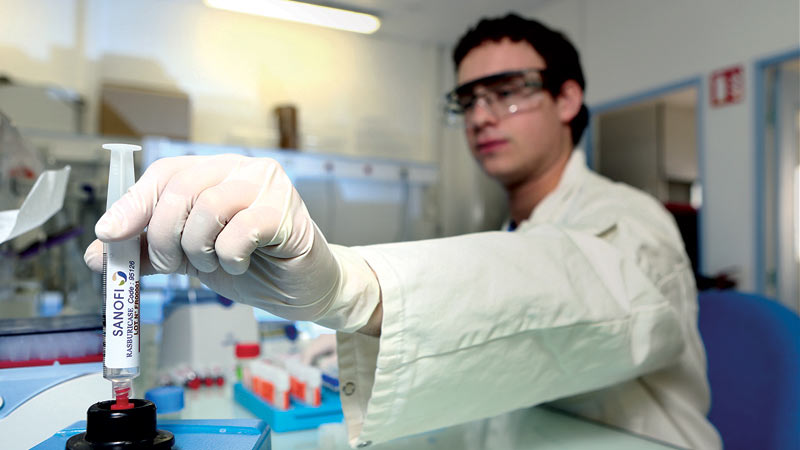Execution Makes or Breaks Product Launch Strategies
Pascale Witz isn’t afraid to shake things up—even if it means looking at customers in a completely different way. When she signed on as executive vice president of global divisions and strategic development at Sanofi S.A., the company was on the cusp of something big. Really big. It was prepping to launch 24 products over the course of five years. In pharma, that’s light speed.
But first, Witz had to reimagine people and processes at one of the world’s largest pharmaceutical makers.
After a 17-year career at General Electric focusing on the health-care business, Witz joined Sanofi in July 2013. She quickly shifted the emphasis away from the drugs and onto the disease and expanded the decision-making target from health-care providers and payers onto patients. Witz then took the astonishing step to think of patients as customers and ask them what they wanted.
Based on what she found, Witz decided to capitalize on Sanofi’s strong diabetes-care track record and make the chronic illness the test case for product launches going forward.
There will be quite a few of those over the next several years. Yet rivals might be forgiven for not seeing much in the multinational company with a long-standing history. A 14-year drought between new-product launches seemed to signal a lackadaisical management approach. The patent on its hugely successful Plavix blood thinner had expired in 2012, and its blockbuster Lantus basal insulin medication is set to go off patent.
Expiring patents daunt the industry as a whole, prompting pharmaceutical companies to launch an estimated 400 new products between 2014 and 2017, a 146 percent increase from 2005. But such a crowded field—especially when the difference between one drug and another can be difficult to see—doesn’t bode well for launch success rates. Some two-thirds of new drug launches fail to meet their pre-launch sales targets, and payers—public, private and individual—are growing less able (or willing) to bear rising costs.
And that’s what makes Witz’s approach so intriguing.
There are approximately 400 million diabetics in the world…and potentially another 179 million people still undiagnosed.
New Regimen
The brutal competition to win a lifetime commitment to a drug regimen defines the diabetes-care category. With some 400 million diabetics in the world—and potentially another 179 million people still undiagnosed—the profit potential for drug makers is enormous.
That, of course, makes Sanofi’s shift of focus from health-care professionals to patients all the more interesting. When Witz brought in patients living with different chronic diseases, including diabetes and atopic dermatitis, and asked how they managed their disease, her peers in the executive ranks found themselves mostly inspired by these face-to-face interactions with the people whose lives they influence.
It was a watershed moment.
“Many company leaders had rarely, if ever, interacted with the ultimate consumers of their products.”
Many company leaders had rarely, if ever, interacted with the ultimate consumers of their products. All executive committee members participated in patient sessions, which were later replicated in Sanofi’s region and country organizations. As a result, thousands of Sanofi employees across the organization, including general managers and department heads, had the opportunity to better understand the needs of people who live with different chronic conditions.
Witz also convened teams of people with experience in and responsibility for diabetes and other diseases across a variety of functional areas, including clinical development, commercialization, market access and market analytics. All of these areas play important roles in a pharmaceutical launch, of course, but seldom work together.
Breaking down those silos resulted in new development and go-to-market processes that Witz reorganized in a matrix structure with patients at the center. By January 2015, she’d created transversal capabilities in key functions such as market access, marketing and strategic development—outgrowths of those cross-functional teams—to move Sanofi to an integrated care model. “It took six months to make this transition,” Witz says, “but it has completely changed the output, the behavior and the morale of the teams.”
And in a shot across the bow of the industry as a whole, Witz hired pediatrician and public health specialist Dr. Anne Beal as the company’s chief patient officer. Serving as a liaison between patients and the company, the role is designed to infuse the patient perspective into everything from product development to marketing to patient outcomes. Sanofi was the first top-10 pharma company to create such a role. “Since then, many others have copied us,” Witz says. But it was a bold move, and one that has delivered real results.
Witz recruited Beal, in part, because she’d spent her career in patient advocacy and wasn’t a pharmaceutical industry insider. Beal “started from the top” in changing the mindset at Sanofi, says Witz, holding sessions where patients and doctors joined the company’s executive committee discussions.
Beal’s job is also helping to change people’s opinion about the industry. “Many people see the pharmaceutical industry as just trying to sell drugs,” Witz explains. “But we are very patient-centric.”

Upending the Traditional Rollout
Now comes the real test of the moves Witz has made to date. With new CEO Olivier Brandicourt at the helm, Sanofi is bringing six new vaccines to market this year, and 18 more products over the next six years—a pace of one rollout every three months. In pharma, that’s light speed.
“We have the opportunity to rewrite medical history,” Witz says.
In February, Sanofi launched Afrezza, the only inhalable insulin on the U.S. market. One month later, the company got a boost with the U.S. Food and Drug Administration (FDA)’s approval of Toujeo, a successor to a type of insulin called glargine that could be a game changer in diabetes treatment. And in July, the company obtained FDA approval of Praluent, a potential blockbuster cholesterol treatment that has had dramatic success in clinical trials.
As change roils the pharmaceutical and health-care spaces, the once orderly rollout of new products has been upended. Yet that need for speed can undermine a solid strategy in the crucial execution phase.
New product rollouts traditionally consist of marketing to physicians, pharmacists and payers—once “the biggest decision-makers,” Witz says. “But in the end, all of these drugs are used by patients.”
That’s why Sanofi’s upcoming rollouts will look and feel so different.
Half of diabetics stop taking insulin within their first year of treatment—often because they don’t understand that the lack of immediate consequences can mask more serious long-term problems, Witz explains. Demonstrating the value of continuing therapy is good not only for patients, but also for drug makers. Share on X
So instead of simply pushing its new insulin drugs, Afrezza and Toujeo, into the sales channel, Sanofi will focus on raising patient awareness and transition to a partial pull model, in which patients request specific medications or information.
The Right Stuff
With so many new drug launches failing to make their projected numbers, companies need to excel at a few things during a launch instead of trying to do everything. For Sanofi, that means building a powerful team focused squarely on forging a true understanding of its customers.
To deepen Sanofi’s customer insight, Witz and her team are incorporating new tools such as real-life data analysis and mobile communications. Three years ago, for example, Sanofi became the first big pharmaceutical company to integrate glucose monitoring with the Apple iPhone so diabetics could share blood sugar information with their families and doctors. While that capability is routine today, it was an important early experiment in mobile integration.
In the areas of cardiovascular and other chronic conditions, the company is working on a huge integrated digital health application that combines quantified self-technologies and advanced computational models for potential early intervention if a patient’s vital signs deviate from normal. This approach has the potential to generate big data that would lead to better understanding of different factors influencing treatment outcome or risks. This might help doctors in selecting the right treatment for patients and help empower patients to take better control of their health.
Data also plays a pivotal role in Sanofi’s upcoming series of product rollouts. Success will be measured not just by sales but also by leading indicators, such as the number of insurers offering coverage for new products.
Even with all that data, Witz knows when to trust her instincts. “I’m a strong believer in analytics,” she says, “but it will not replace experience—that gut feeling.”
Witz knows the company’s ambitious rollout means she and her team will have to perform at 100 percent—and then some.
“I’m proud that people sometimes say, ‘Pascale pushes you to deliver more than what you thought was possible,’” she says.
Witz has populated her team with both internal and external professionals from such fields as medical devices, diagnostics, market access and integrated care. “Diverse teams are more productive than teams where everyone thinks the same way,” she says. “At Sanofi, this diversity starts at the executive committee level, where we have people with different nationalities, backgrounds and expertise. I believe this is a key success factor making a team capable of pursuing bigger goals and delivering results. You become better when you challenge yourself with people who are better than you are. Share on X
Her success will also depend heavily on her team’s ability to collaborate. “I want the team to tackle problems together,” she says. But that doesn’t mean she’ll be entirely hands-off. “I spend time with them when they’re facing their most challenging problems,” Witz adds.
She doesn’t want to just hear happy news, either. “I strongly believe that when you manage a complex portfolio, it’s important to be able to flag things when they aren’t going well,” she says. “Leadership style has an impact on the culture and people’s behavior, and ultimately on business results. We get together to achieve bigger goals—this requires that we tackle hurdles and difficulties in a timely and open manner. Only an open, collaborative team that can challenge itself can succeed in the long run,” she adds.
A former national champion in the 400-meter hurdles, Witz still runs—and still draws on lessons learned as an athlete. Three years ago, she completed a marathon in three hours and 50 minutes, about nine minutes a mile. But her focus wasn’t on competition as much as doing her best. That’s what competitive sports are about, she says, and the same principles apply in business.
Witz, who has been appointed to lead Sanofi’s diabetes and cardiovascular global business unit in the company’s new structure, starting January 2016, is passing that core message onto her team.
“Our CEO Olivier Brandicourt is a leader with a clear vision for the future, and I am pleased to be part of the team shaping the future for Sanofi. However, you don’t make an impact by yourself,” Witz says. “You make it by the teams you lead—hiring great people and making them do more than they’d do by themselves. I’ve always been motivated by having an impact on people’s heath. I hope 10 years from now, I’ll be able to say I developed great people and changed the lives of many people all over the world.”



